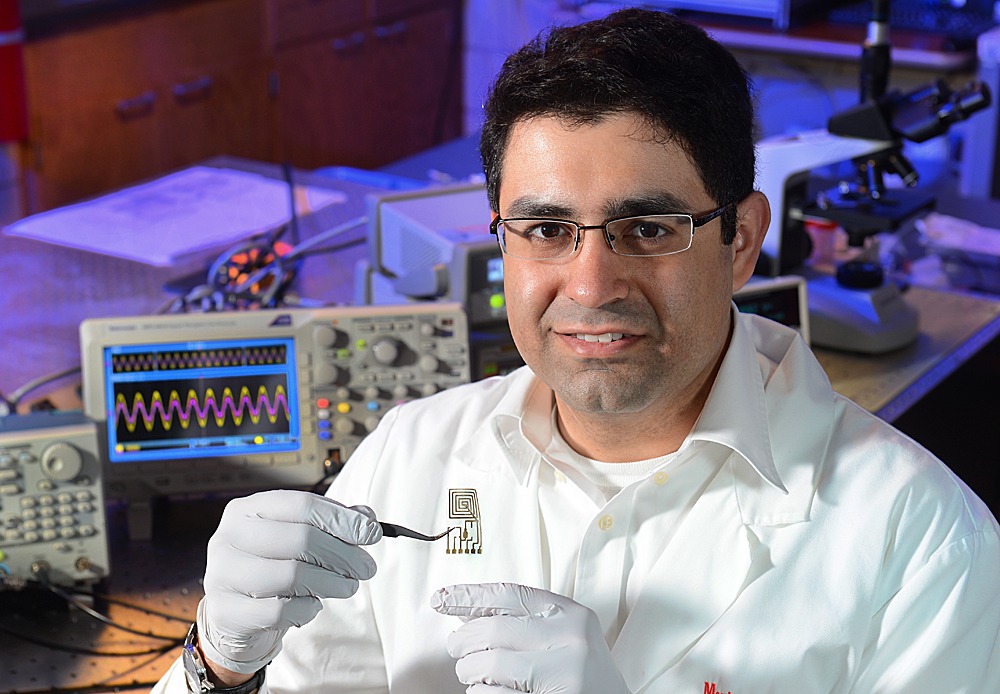
Iowa State's Reza Montazami examines a degradable antenna capable of data transmission. Larger image. Photo by Bob Elbert.
AMES, Iowa – A medical device, once its job is done, could harmlessly melt away inside a person’s body. Or, a military device could collect and send its data and then dissolve away, leaving no trace of an intelligence mission. Or, an environmental sensor could collect climate information, then wash away in the rain.
It’s a new way of looking at electronics: “You don’t expect your cell phone to dissolve someday, right?” said Reza Montazami, an Iowa State University assistant professor of mechanical engineering. “The resistors, capacitors and electronics, you don’t expect everything to dissolve in such a manner that there’s no trace of it.”
But Montazami thinks it can happen and is developing the necessary materials.
He calls the technology “transient materials” or “transient electronics.” The materials are special polymers designed to quickly and completely melt away when a trigger is activated. It’s a fairly new field of study and Montazami says he’s making progress.
The research team he’s leading, for example, is developing degradable polymer composite materials that are suitable platforms for electronic components. The team has also built and tested a degradable antenna capable of data transmission.
The team presented some of its research results at the recent meeting of the American Chemical Society in Dallas.
And, a paper describing some of the team’s work, “Study of Physically Transient Insulating Materials as a Potential Platform for Transient Electronics and Bioelectronics,” has just been published online by the journal Advanced Functional Materials.
The paper focuses on the precise control of the degradation rate of polymer composite materials developed for transient electronics.
Montazami is the lead senior author of the paper. Iowa State co-authors are Nastaran Hashemi, an assistant professor of mechanical engineering; Handan Acar and Simge Cinar, postdoctoral research associates in mechanical engineering; and Mahendra Thunga, a postdoctoral research associate in materials science and engineering and an associate of the U.S. Department of Energy’s Ames Laboratory. Michael Kessler, formerly of Iowa State and now professor and director of Washington State University’s School of Mechanical and Materials Engineering in Pullman, is also a co-author.
The research has been supported by Montazami’s startup funds from Iowa State. He’s pursuing grants to support additional projects.
“Investigation of electronic devices based on transient materials (transient electronics) is a new and rarely addressed technology with paramount potentials in both medical and military applications,” the researchers wrote in the paper.
To demonstrate that potential, Montazami played a video showing a blue light-emitting diode mounted on a clear polymer composite base with the electrical leads embedded inside. Add a drop of water and the base and wiring begin to melt away. Before long the light goes out and a second drop of water degrades what little is left.
The researchers have developed and tested transient resistors and capacitors. They’re working on transient LED and transistor technology, said Montazami, who started the research as a way to connect his background in solid-state physics and materials science with applied work in mechanical engineering.
As the technology develops, Montazami sees more and more potential for the commercial application of transient materials.
Just think, he said, if you lose your credit card, you could send out a signal that causes the card to self-destruct. Or, sensors programmed to degrade over certain times and temperatures could be stored with food. When the sensors degrade and stop sending a signal, that food is no longer fresh. Or, when soldiers are wounded, their electronic devices could be remotely triggered to melt away, securing sensitive military information.